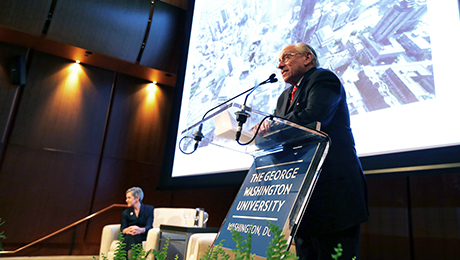By Gray Turner
On Thursday, nearly 200 members of the George Washington University community received a unique insider’s perspective on the work being done at the World Trade Center site during the fifth annual GW Wall Street Symposium in New York City.
This year’s symposium featured a keynote from Larry Silverstein, developer of the World Trade Center buildings and grandfather of GW student Cory Silverstein, and an interview-style conversation between Mr. Silverstein and Diana Henriques, B.A. ’69, a member of the George Washington University Board of Trustees, senior financial writer for the New York Times and bestselling author.
Each spring, GW and its Real Estate & Finance Alliance (REFA)—a network of alumni and friends working in all facets of the real estate and financial services industries—host the Wall Street Symposium to bring together GW alumni, parents and friends for an intimate discussion with an industry leader.
The symposium began when Jared Golub, B.B.A. ’00, REFA co-chair, welcomed attendees at the historic Morgan Library & Museum in Midtown Manhattan. A complex of buildings in the heart of New York City, the Morgan Library & Museum began as the private library of financier J.P. Morgan, one of the preeminent collectors and cultural benefactors in the United States.
GW trustee and parent Lee Fensterstock then took the stage and introduced Mr. Silverstein, a guest of honor who “needs little in the way of introduction to New Yorkers.”
“Silverstein Properties develops, owns and manages 35 million square feet of multipurpose space in Manhattan, with $8 billion worth of development in the pipeline,” said Mr. Fensterstock. “Most notably, of course, are the World Trade Center buildings owned by Silverstein Properties, the newest of which opened last fall and is heralded as ‘the most advanced office building of the 21st century.’”
In his address, Mr. Silverstein touched upon the history of the World Trade Center following the September 11th attacks—from the collapse of the buildings and the response of New Yorkers on the ensuing days and weeks to the opening of 4 World Trade Center, 7 World Trade Center and the National September 11 Memorial & Museum, which opened to the public the day before the symposium.
He described the story of the new World Trade Center as a story “of how New York bounces back, how New York shows resilience, how New York recreates itself.”
Working in concert with the Port Authority of New York and New Jersey, Silverstein Properties hired three award-winning architects to “knit these new buildings back into the surrounding community and enliven the street-level experience with grand open spaces, a train station and new stores.”
Mr. Silverstein addressed the importance of green technology and design in the new buildings during his presentation, stating that “major advances in technology in the last 15 years have improved architectural efficiency and flexibility, access to natural light, temperature control, energy consumption and cost savings.”
7 World Trade Center became the first LEED Gold-certified office building in New York City when it opened in 2006, making it a model for the other towers being built at the site. Mr. Silverstein said that 7 World Trade Center is also one of the safest buildings ever built.
Mr. Silverstein spoke in depth about the growth in the area of Lower Manhattan surrounding the new World Trade Center, citing the 455 companies and 30,000 people that have moved to the area over the last decade.
“All around the Trade Center, Lower Manhattan has been transformed into one of the best places to live, to work and to visit,” he said.
In his closing remarks, Mr. Silverstein relayed his hopes that the work being done to rebuild the World Trade Center would be viewed as a fitting tribute to those lost on 9/11 and to all of New York.
“Together, we are reinventing what it means to be a city for the 21st century,” he said.
The program then switched to an interview-style format, with Ms. Henriques and Mr. Silverstein discussing topics ranging from the public partnerships necessary to complete ambitious projects like the World Trade Center to Mr. Silverstein transitioning control of the company he built to a new generation of developers.
After the program, attendees enjoyed drinks and hors d’oeuvres in the lower level of The Morgan Library & Museum, which featured several pieces of the museum’s extensive art collection. A small dinner was then held in Mr. Morgan’s Library, which holds thousands of volumes and important cultural works, including a plaster “life mask” of George Washington made by the French sculptor Jean-Antoine Houdon just four years before Washington took office as the country’s first president.
The event was one of several hosted around the country annually for alumni and donors by GW’s Luther Rice Society, the university’s oldest donor recognition society. In conjunction with its industry alliances—REFA and the Entertainment, Media & Marketing Alliance (EMMA)—the Luther Rice Society develops programs that engage alumni and donors with unique opportunities for interaction, exploration and conversation.
“These types of events are about bringing together a diverse group of GW alumni,” said Luther Rice Society Co-Chair Dean Coclin, B.S. ’84. “Luther Rice Society events—business events, cultural events, sporting events—take place all around the country each year. They galvanize our alumni and showcase what the university is accomplishing on its campuses and in the professional world.”


